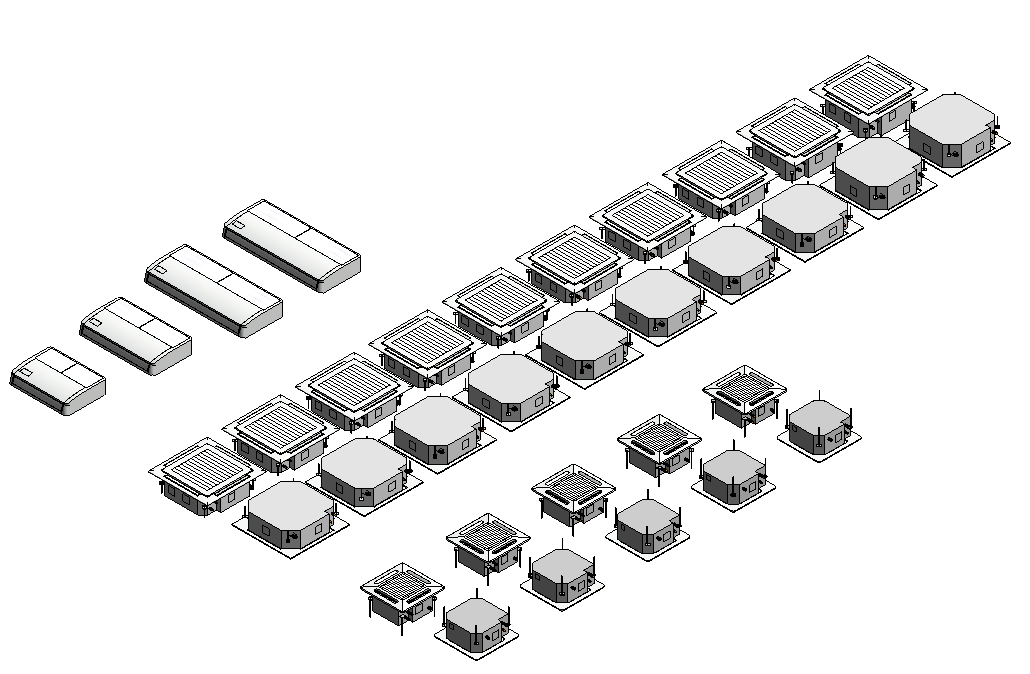
While it’s only August, so far it would be safe to say that 2017 has been our hottest year on record for VRF Revit content. VRF stands for Variable Refrigerant Flow, and it’s a type of HVAC system that can do modulated and mixed heating and cooling. We’ve had multiple projects from multiple manufacturers and created a wide range of VRF components throughout 2017. This made me curious to learn more about where VRF products fit in the industry and why the sudden increase in interest.
While we don’t know the exact reasons for the uptick in requests for VRF Revit content this year, we do know that VRF systems are steadily gaining in popularity. This is especially true in the US, where they are still only a small fraction of installed systems. VRF is a technology from Japan that’s been available since 1982 and which is already in wide use across Asia and Europe.(1) It’s more energy-efficient (by modulating the level of refrigerant instead of using a simple on/off) and more flexible (by doing mixed heating and cooling) than other HVAC systems for many common building applications. As a global market, it’s already worth more than $10B and is projected to reach more than double that in the next 5 years.(2) So perhaps it should come as no surprise that more AEC firms are looking to use VRF systems in their projects, and that this translates into manufacturers making more VRF Revit families.
From a content perspective, the main complexities tend to be connectors and ensuring that all technical specs are accurate for all types. With connectors, VRF product line-ups can have units with multiple numbers, types and locations for system connectors, such as units with options for heat recovery, drain pumps and filter boxes. In terms of technical specs, such as electrical and piping data, certain VRF units can have a whole host of possible configurations, some of which may not be immediately clear from standard product documentation.
With both system connectors and technical specs, the critical step is to talk through all product options with the manufacturer and not just rely on documentation. Even if you don’t end up incorporating every product option into the Revit family – because some are too customizable or very rarely requested or not useful for Revit’s purposes – it’s important to know the full range of possible configurations and ideally to create content that can easily incorporate them in the future.
Below are some highlights from our recent VRF projects where you can see the different types of components and the range of sizes and configurations that go into a VRF system. While the family geometry is generally quite regular in shape, the exterior connections, knockouts and grilles help to keep us on our toes. Getting those small details right is important both for recognizing the desired product/configuration as well as for accurate coordination and calculations in Revit.
The families all include three levels of detail in both 3D and 2D and have materials applied for 3D fine views and renderings. Where appropriate, they also include clearance zone geometry (in both 3D and 2D), optional hanger visibility, connector position options, and type catalogs to cover different sizes and technical configurations. The families range in file size from under 400KB for the Y branch fittings to just over 1MB for some multi-unit outdoor pumps and multiport distribution controllers, with an average of about 700KB, giving you top-notch usability and smooth performance in your Revit projects.
Outdoor heat pumps with heat recovery capability.

Indoor underceiling and cassette heat pumps.

Ceiling void indoor heat pumps.

Indoor exposed and recessed floor model heat pumps.

Indoor exposed floor heat pump in elevation view with subcategories showing.

Indoor exposed floor heat pump with knockout options highlighted.

Underceiling heat pump with standard knockout (left) and optional drain pump (right).


Outdoor twin 30-ton (left) and 18-ton (right) heat pumps


Change-over box units with 1, 4, 8 and 12 port configurations.
Plan view of change-over box units with 1, 4, 8 and 12 port configurations.

Y branch pipe fittings for outdoor heat pumps in fine (left) and medium/coarse (right).


Rendering of copper Y branch pipe fitting for outdoor heat pumps.

And that’s a wrap!
We hope you’ve enjoyed this summer showcase of VRF Revit families, and here’s to the continued growth and success of more energy-efficient HVAC systems!
Notes
1. Joanna R. Turpin, “VRF Market Expected to Hit $24B by 2022”, The Air Conditioning, Heating and Refrigeration NEWS, http://www.achrnews.com/articles/134465-vrf-market-expected-to-hit-24b-by-2022, (February 13, 2017).
2. Ibid.

